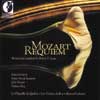Mozart Requiem
Levin’s realisation of Mozart’s Requiem performed at an extraordinary time
View record and artist detailsRecord and Artist Details
Composer or Director: Wolfgang Amadeus Mozart
Genre:
Vocal
Label: Dorian
Magazine Review Date: 3/2003
Media Format: CD or Download
Media Runtime: 53
Mastering:
Stereo
DDD
Catalogue Number: DOR90310

Tracks:
| Composition | Artist Credit |
|---|---|
| Requiem |
Wolfgang Amadeus Mozart, Composer
(La) Chapelle de Québec (Les) Violons du Roy, Québec Bernard Labadie, Conductor Karina Gauvin, Soprano Marie-Nicole Lemieux, Contralto (Female alto) Nathan Berg, Baritone Wolfgang Amadeus Mozart, Composer |
Author: Stanley Sadie
This is a strong, dramatic performance of the Mozart Requiem, which initially I thought looked like being able to challenge almost any in the catalogue. The opening has due deliberation and gravity, and the ‘Kyrie’ moves vigorously, with clean and precise choral singing; then the turbulent music of the Sequentia section is powerfully done, by a conductor who knows how to establish and sustain momentum. And there is some telling detail, such as the menacing swells on the violin phrases in the ‘Dies irae’. I also particularly admired the ‘Domine Jesu’, with the ‘Quam olim Abrahae’ fugue specially impressive.
But it doesn’t do to exaggerate the drama or the pathos in this work; and the dragged tempo for the ‘Lacrimosa’, the ponderous ‘Hostias’ and the very slow tempi in some of the later movements are ineffective, almost to the point of sentimentalising. This recording was made in New York State a few days after the terrible events of September 11, 2001 and one can well understand if the mood of the moment dictated the kind of performance it had to be. But while noting that, and sympathising with it – and recognising, too, that as a memento of the occasion it has a special significance – I have to judge it now just like any other version.
There is firm, assured choral singing, although the choral ensemble sound isn’t perhaps ideally defined. The solo soprano, in spite of a considerable vibrato, sings movingly; the middle solo voices are unusually mellifluous and the bass is just about sturdy enough for the ‘Tuba mirum’.
Bernard Labadie elected to use the completion by Robert Levin. Listening to it again, I have to say that, much as I admire Levin’s profound musicianship and his Mozartian insights, I am by no means happy with some of what he does. The fugal ‘Amen’, based on Mozart’s own sketches for a movement he never wrote, is for the most part effective, but has some uncomfortable moments, and there is music in his revised ‘Osanna’ that just doesn’t work – and nor, above all, does his introduction to the ‘Osanna’ repeat. At many points there are changes that strike me as arbitrary and sometimes seriously misguided, and I’m inclined to think that for all his flaws Süssmayr, with some of the detail gently modified, remains the best option we have.
But it doesn’t do to exaggerate the drama or the pathos in this work; and the dragged tempo for the ‘Lacrimosa’, the ponderous ‘Hostias’ and the very slow tempi in some of the later movements are ineffective, almost to the point of sentimentalising. This recording was made in New York State a few days after the terrible events of September 11, 2001 and one can well understand if the mood of the moment dictated the kind of performance it had to be. But while noting that, and sympathising with it – and recognising, too, that as a memento of the occasion it has a special significance – I have to judge it now just like any other version.
There is firm, assured choral singing, although the choral ensemble sound isn’t perhaps ideally defined. The solo soprano, in spite of a considerable vibrato, sings movingly; the middle solo voices are unusually mellifluous and the bass is just about sturdy enough for the ‘Tuba mirum’.
Bernard Labadie elected to use the completion by Robert Levin. Listening to it again, I have to say that, much as I admire Levin’s profound musicianship and his Mozartian insights, I am by no means happy with some of what he does. The fugal ‘Amen’, based on Mozart’s own sketches for a movement he never wrote, is for the most part effective, but has some uncomfortable moments, and there is music in his revised ‘Osanna’ that just doesn’t work – and nor, above all, does his introduction to the ‘Osanna’ repeat. At many points there are changes that strike me as arbitrary and sometimes seriously misguided, and I’m inclined to think that for all his flaws Süssmayr, with some of the detail gently modified, remains the best option we have.
Discover the world's largest classical music catalogue with Presto Music.

Gramophone Digital Club
- Digital Edition
- Digital Archive
- Reviews Database
- Full website access
From £8.75 / month
Subscribe
Gramophone Full Club
- Print Edition
- Digital Edition
- Digital Archive
- Reviews Database
- Full website access
From £11.00 / month
Subscribe
If you are a library, university or other organisation that would be interested in an institutional subscription to Gramophone please click here for further information.




